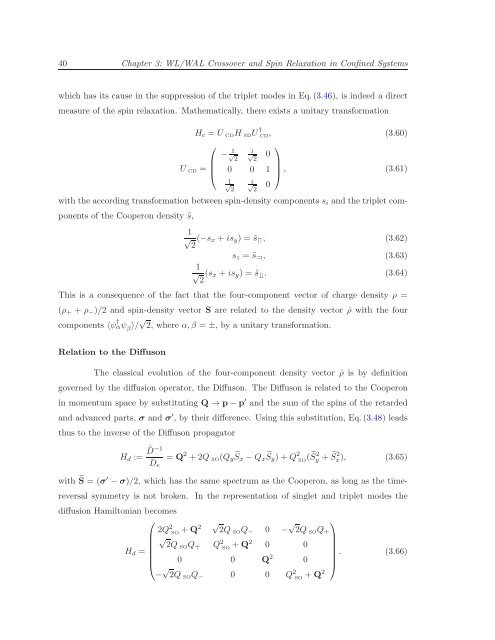Itinerant Spin Dynamics in Structures of ... - Jacobs University
Itinerant Spin Dynamics in Structures of ... - Jacobs University
Itinerant Spin Dynamics in Structures of ... - Jacobs University
You also want an ePaper? Increase the reach of your titles
YUMPU automatically turns print PDFs into web optimized ePapers that Google loves.
40 Chapter 3: WL/WAL Crossover and <strong>Sp<strong>in</strong></strong> Relaxation <strong>in</strong> Conf<strong>in</strong>ed Systems<br />
which has its cause <strong>in</strong> the suppression <strong>of</strong> the triplet modes <strong>in</strong> Eq.(3.46), is <strong>in</strong>deed a direct<br />
measure <strong>of</strong> the sp<strong>in</strong> relaxation. Mathematically, there exists a unitary transformation<br />
H c = U CD H SD U † CD, (3.60)<br />
⎛ ⎞<br />
U CD =<br />
⎜<br />
⎝<br />
− 1 √<br />
2<br />
i √<br />
2<br />
0<br />
0 0 1<br />
1√<br />
2<br />
i √<br />
2<br />
0<br />
⎟<br />
⎠ , (3.61)<br />
with the accord<strong>in</strong>g transformation between sp<strong>in</strong>-density components s i and the triplet components<br />
<strong>of</strong> the Cooperon density ˜s,<br />
1<br />
√<br />
2<br />
(−s x +is y ) = ˜s ⇈ , (3.62)<br />
s z = ˜s ⇉ , (3.63)<br />
1<br />
√ (s x +is y ) = ˜s . 2<br />
(3.64)<br />
This is a consequence <strong>of</strong> the fact that the four-component vector <strong>of</strong> charge density ρ =<br />
(ρ + + ρ − )/2 and sp<strong>in</strong>-density vector S are related to the density vector ˆρ with the four<br />
components 〈ψ † αψ β<br />
〉/ √ 2, where α,β = ±, by a unitary transformation.<br />
Relation to the Diffuson<br />
The classical evolution <strong>of</strong> the four-component density vector ˆρ is by def<strong>in</strong>ition<br />
governed by the diffusion operator, the Diffuson. The Diffuson is related to the Cooperon<br />
<strong>in</strong> momentum space by substitut<strong>in</strong>g Q → p−p ′ and the sum <strong>of</strong> the sp<strong>in</strong>s <strong>of</strong> the retarded<br />
and advanced parts, σ and σ ′ , by their difference. Us<strong>in</strong>g this substitution, Eq.(3.48) leads<br />
thus to the <strong>in</strong>verse <strong>of</strong> the Diffuson propagator<br />
H d :=<br />
ˆD<br />
−1<br />
= Q 2 +2Q SO (Q y˜Sx −Q x˜Sy )+Q 2<br />
D (˜S SO y 2 + ˜S x 2 ), (3.65)<br />
e<br />
with ˜S = (σ ′ −σ)/2, which has the same spectrum as the Cooperon, as long as the timereversal<br />
symmetry is not broken. In the representation <strong>of</strong> s<strong>in</strong>glet and triplet modes the<br />
diffusion Hamiltonian becomes<br />
⎛ √<br />
2Q 2 SO<br />
+Q 2 2Q SO Q − 0 − √ ⎞<br />
2Q SO Q +<br />
√ 2Q SO Q + Q 2 SO<br />
H d =<br />
+Q2 0 0<br />
. (3.66)<br />
⎜<br />
⎝ 0 0 Q 2 0 ⎟<br />
− √ ⎠<br />
2Q SO Q − 0 0 Q 2 SO<br />
+Q 2
















